
Quarter-inch long Scarlet O'Hara morning glory seeds on the left, eighth-inch long Star of Yelta on the right

Wayne
Schmidt's Morning Glory Page
(Note:
if your monitor is set to 72 ppi then the flower pictures will be
the same size as the actual flowers.)
2011 SEASON IS UNDERWAY!!!
Introduction:
Like 1,000,000 other homes in southern California, my backyard is enclosed by a 6-foot tall concrete block wall. Though functional, it's unattractive and reflects scorching heat and light onto plants growing close to them. A quick and inexpensive solution is to cover the wall with a flowering vine. Although there and many perennial vines that would serve admirably, I decided to try Morning Glories.
Before rushing to the nearest garden center to load up on packets of morning glory seeds, I browsed cyberspace to find the best varieties. I was disappointed to discover that in spite of their universal popularity there is remarkably little detailed information available on morning glories. There are dozens of sites that provide generic descriptions of flower color and size and how high some species can climb but I couldn't find any that describe how well a particular species preforms as a wall cover, how long the flowers remain open, how good a climber it is or how well the flowers cover the plant. Hence this page.
On it you will see full-sized, true color pictures of the flowers for each variety I've grown as well as pictures of how well that species works as a visual barrier. Also included are comments about the pros and cons of each variety. The page began in 2009 and carried through 2010, covering 25 varieties.
All of the morning glories featured on this page are grown in my high desert location in southern California with summer highs typically around 100-degrees, humidity 12-percent and night time lows of 66-degrees. Although heavily amended with shredded leaves and peat moss every year, my arid soil remains slightly alkaline, around 7.2. Bed depth is a good 18-inches and fitted with a drip system. The morning glories are planted 6-inches from the base of the concrete block wall so their roots come in contact with the wall's cement footing, consequently their soil will be slightly more alkaline. The plants trail up concrete reinforcing cloth (1/8-inch diameter wires welded into a mesh with 6x6-inch squares) that is 6-feet tall. Although many varieties of Morning Glories can reach 20 feet tall, mine are all trained to be only 6-feet high.
For the comparisons on this page, I'm growing five plants for every 5-foot wide trellis to compare how well each variety hides the block wall behind it.
Getting
Started: Planting
Morning Glory seeds are very hard tear-dropped shaped seeds that are usually dark brown or black, though a few varieties sport buff-colored seed. They vary in size from 1/16th inches long all the way up to 1/2-inch.

Quarter-inch
long Scarlet O'Hara morning glory seeds on the left, eighth-inch
long Star of Yelta on the right
Because they are very hard, most references suggest soaking the seeds over night or for 24 hours prior to planting, supposedly improving the rate and speed of germination. I have my doubts because as the photo below shows:
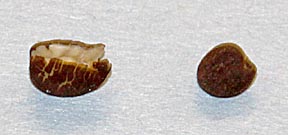
Soaked
Star of Yelta seed on the left, unsoaked on the right.
(Enlarged
to show detail.)
Most of the seeds swell so much they practically explode. I tested this technique by soaking twenty seeds of each of five different varieties of morning glories and planting in line with 20 unsoaked seeds. Three days later the seeds had germinated.
![]()
Crimson
Rambler seedlings. The left half was unsoaked seeds while the right
half was soaked seeds.
Germination rates were the same for both soaked and unsoaked seeds, about 75-percent, and the speed with which the seedlings appeared was also the same. The other four test plantings demonstrated the same results. For myself, I'm going to skip soaking the seeds if for no other reason than it makes them harder to handle.
However you prepare your seeds, plant them 1/2 to 1-inch deep and keep moist until they sprout. After that, time waterings according to what they plants tell you: if they start to wilt, water. I've experimented with both light and heavy watering schedules and morning glories appear to adapt to whatever they are given. But note, they get to be large vines with comparatively small root systems so I prefer to water regularly and deeply. Germination takes 7 to 10 days in early Spring but only three in the heat of summer. If given good soil and favorable conditions you should be seeing your first flowers in two months, though it'll take three for the plants to produce full displays.
All the references I've read suggest thinning seedlings once they are 1 inch tall to 12-inches apart. My problem with this is that a 1 inch plant is so small it would easy for a cut worm to nibble it off. I prefer to let mine grow until the are at least three inches tall. That way if one gets savaged by a cutworm there are many more left. Thin too early and cutworms might mow them all down.
Another problem I have with most references is that they warn people that morning glories don't like having their roots disturbed. Half of the Mt. Fuji morning glories in my garden were dug up and moved to different locations without a single one being lost. As long as normal precautions are taken, my experiences suggest that transplanting morning glories is no more problematic than any other annual.
One thing to be aware of if your morning glories are going to share a bed with other bedding plants is that after three months they will bunch out from the wall even if the trellis on which they are growing is right up next to the wall.
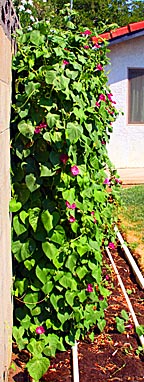
Bright
Eyed Girl morning glories
As the photo above shows, they extend a good two feet over the bed. This was an important discovery for me because next year I plan on filling the bed with RANUNCULUSES and training 12 different varieties of morning glories up the wall behind them. Needless to say any bedding plants within two feet of the wall would be covered, so I'll only be planting the outer 18 inches of the bed with flowers.
By far the most interesting thing I've been following during the morning glory comparisons for this page is their flowering patterns. While their name suggests they flower mainly in the morning, I've discovered that when they flower is most strongly determined by air temperature, enabling many varieties to remain open all day long in cool weather. Some varieties can open when the temperatures are in the fifties while others wait until the air warms up into the 60s. Some close as soon as they hit 80 degrees while plants right next to them stay open above 90. Strangest of all, when cool Fall temperatures arrived in my backyard several varieties seemed to reset their flowering temperatures. Plants that were reluctant to open flowers below 60 degrees were suddenly greeting me first thing in the morning with beautiful displays even when the air temperature was a brisk 45 degrees. Another effect of cooler weather is that flower size is half of what it was during summer.
I haven't experienced any significant insect or disease problems with the varieties I tested do date.
And without further delay... on to the reviews: Note: My reviews and recommendations are based on how each morning glory looked in my garden. Soils and weather vary so don't take these as universally true.
Morning
Glory Variety Reviews:
Heavenly Blue
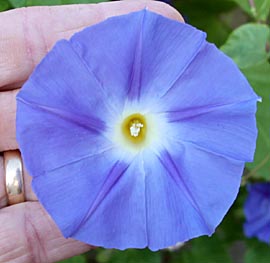
One of the most popular morning glories. The extremely refined flowers average 3-inches in diameter and are a clear sky blue. They open shortly after temperatures rise above 60 degrees and remain open until 2 PM unless air temperature top 105 degrees. If morning temperatures are in the 50s, they remain closed until the air warms up.

Although it's by far the best climber of the first three morning glories on this page, I rate Heavenly Blue as a poor wall covering because it has a tendency to drop leaves off the bottom half of the plant. Although the individual flowers are attractive, their subtle coloring doesn't make them very eye-catching from a distance. Add to this the straggly look of the plant's crown and I have to recommend skipping this variety.
Bright Eyed Girl
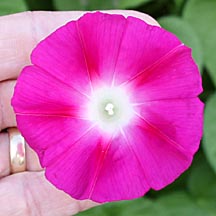
Although only 2.5-inch across, the shockingly bright magenta color and brilliant white "eye" make this flower a real eye-catcher. It's one of those flowers that's so pretty it evokes many double-takes and is hard to look at without feeling the itch to smile.
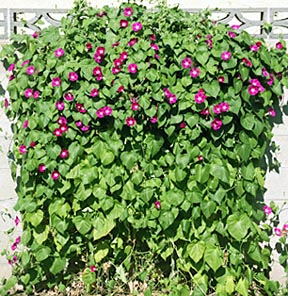
Note:
the brilliance of the flowers is much greater in person that this
photo suggests.
Bright Eyed Girl is an excellent self-climber and covered the trellis with a solid mat of attractive, heart-shaped leaves. It produces a large number of flowers that open even if the temperatures are in the 50s, providing a beautiful view to welcome the day. Unfortunately the flowers fade as soon as air temperatures hit 90 degrees, around 10 AM in my location during summer. (Air temperature seems more important that sun light intensity in determining when morning most glory flowers start to fade.) On days where the temperature remains in the 70s, the flowers may stay open all day. I recommend Bright Eyed Girl to anyone wanting a solid wall of green with beautiful morning flowers.
Bright Eyed Girl morning glories produce heart shaped leaves typical to most morning glories, though larger than most.

Mt. Fuji
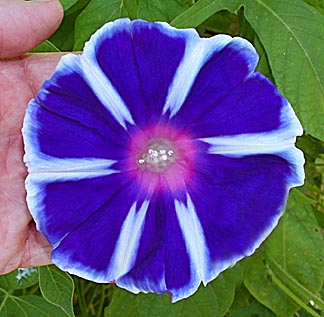



Available only as a mix of blue, magenta and purple with distinctive white stars and a solid pink, Mt. Fuji morning glories produce beautiful four to five inch diameter flowers. Unfortunately, there is a high price to pay for this beauty. The plant is a terrible climber. I had go out every day to twist the vines around the trellis. They simply wouldn't climb on their own, preferring to sprawl over the ground. Combine their poor climbing ability with extremely rapid growth and you have a real challenge to control this variety. On the other hand the flowers can be beautiful and last all day on the plant, many opening late in the afternoon. Countering this is the fact that only one quarter of the flowers open as shown in the photos above. The petals of Mt. Fuji morning glories are extremely thin and fragile, particularly the magentas. Very few open cleanly. Most, particularly the magenta ones, end up looking shredded, like the following:
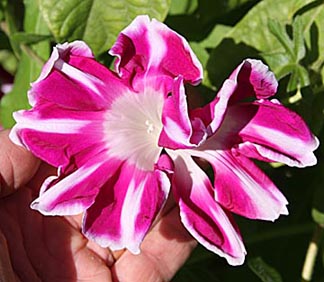
Typical
Mt. Fuji magenta bloom
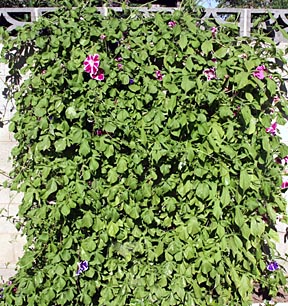
There are three times as many flowers on the plant than visible in this picture. Most of the flowers are produced deep inside and are difficult to see. The plant covers the wall well, but only with a lot of training. Unlike the typical heart shaped leaves of most morning glories, Mt. Fuji produces deeply cut lobed leaves. Plants bearing blue, magenta or purple flowers also have white mottlings on their leaves.
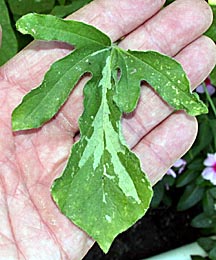
Plants with pink flowers don't have these markings. Many seed companies push the variegated foliage as a bonus. In fact, the mottling is difficult to notice from anything over ten feet away and almost completely vanished from my plants by the time they were three months old. I don't know if this was the result of age or high summer temperatures. A big problem with the foliage is that the vines are thick and very tough, making their removal from the trellis extremely tedious at the end of the season.
With all the negatives you might think I'd give these plants a very negative review. Yet Mt. Fuji morning glories offer a unique capability that may redeem them to some growers: they make excellent cut flowers.

"Excellent," at least, in comparison to other morning glories. Cut as soon as they open and placed in bud vases the flowers will last up to 18 hours inside. As the image above shows, they make a striking display. The only caution is to avoid dripping water on the petals. The color washes off.
If you want a hands-off climber that covers a wall with flowers I'd have to recommend staying away from Mt. Fuji morning glories. But, if you don't mind a lot of training work and you want a few very attractive flowers you might want to give them a try. If so, I recommend planting them thinly, one plant every two feet, and place the trellis very close to a wall so flowers are forced to face outward. Since they require a lot of hands-on care in training, space the vines as openly as possible so the flowers can be seen.
FALL UPDATE!
It is now 25 September and the first flowers from the 19 August planting are opening. That's only five weeks from planting to flowering. The first flower to open, on 24 September, was a Star of Yelta. The vines were barely 2-feet tall. Unfortunately I wasn't able to get a photo of it. On 25 September the first Grandpa Ott opened and I was able to get a picture of it so the Fall report will begin with it.
Grandpa Ott
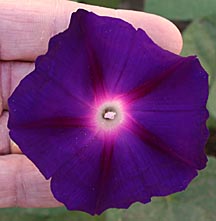
At five weeks old my Grandpa Otts were barely 18-inches tall when the first flower opened. It was a nearly black, velvety purple with a bright center and measured only 2.75 inches across. Although it's far to early to pass judgement on the plant as a whole, I would have a difficult time recommending this variety. The flower color is extremely somber while my preference is for bright hues that elicit smiles, like those of Bright Eyed Girl. Grandpa Ott is an excellent climber and like most morning glories only needs a nudge toward the trellis to get started when it first starts growing.
Star of Yelta
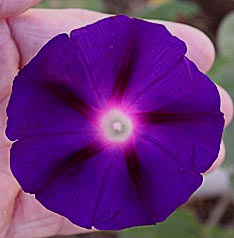
I have to confess that Star of Yelta and Grandpa Ott look nearly identical to me. Star of Yelta flowers may be very slightly larger and a touch lighter but side-by-side I doubt if I could tell the difference. (The photos depict much more difference than in real life.) The plants are identical in so many ways that I wouldn't be surprised to learn that they were the same, but sold under two different names. Assuming they are two different varieties, my preference would be for Star of Yelta. It appears to grow slightly faster, the flowers are a little larger, it produces more of them and they have a more circular shape. However, these differences are so subtle that they may be the result of plant-to-plant variations rather than true varietal differences.
On cool days, some flowers may remain open over night, providing a doubling of your flowers the next day. The picture below of Star of Yelta flowers shows that the ones that survive the night are faded (the flower on the right) and tend to be a little shriveled.

These hanger-on flowers also close up very early on their second day.
Star of Yelta plants fill in nicely to provide a solid wall covering.
Crimson Rambler
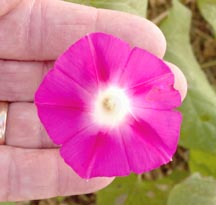
I found Crimson Rambler virtually identical to Bright Eyed Girl. Although the flower in the photo above is slightly smaller than those of the Bright Eyed Girl shown earlier, that's because it was taken after the weather cooled and as with many morning glories, flower size had deceased. The plant appears similar as well, though it didn't had the chance to mature to the same size.
Blue Star
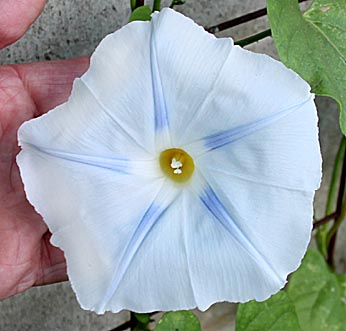
Blue Star produces large numbers of huge, pale blue flowers. As attractive as they are, they suffer from the same problem of Heavenly Blue, they just don't project the bright, exuberant color of Bright Eyed Girl.
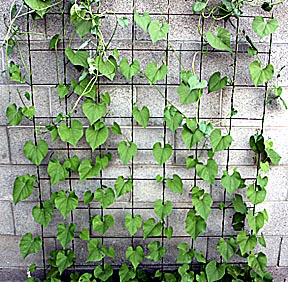
Blue Star plants are unusual for morning glories in that they produce almost no side runners. The plants grow upward as single vine, creating an open look that doesn't work well as a wall cover. They grow extremely fast and when planted as a low screen tend to flop over unattractively. Pinching the tips produces top-heavy growth so I recommend pinching early. Where this plant might be useful would be at the end of a covered porch where a green barrier is wanted that is open and airy. An early frost killed this specimen before it managed to show its full potential.
Retested in 2010, this plant put on an impressive show by producing large qualtities of large, beautiful flowers. But, late in the season the leaves of both it and its look-alike Milky Way (please see below) had taken on an unhealthy yellow color that suggested a virus had infected them. None of the surrounding morning glories shouwed any sign of the problem. Also, these plants seemed to attract aphids while none of the other morning glories were bothered by them.
2010 SEASON IS UNDERWAY!!!
On April 28 I planted Scarlet O'Hara (retest), Blue Picotee, Minibar, Yellow, Sunsmile Red, Blue Star (retest), Candy Pink, Andersonii Pink, Pastel Star Mix, Cardinal Climber and Cameo Elegance morning glory seeds. By early July they should have grown tall enough for me to post pictures of the flowers and cultural information. One oddity is that the Blue Star Morning Glory Mix seeds came in two types: a large black and small white seeds. I planted each in a different area to see if there is any significance to this.
May
7 Update:
Another 50 feet of bed opened up after my ranunculuses finished their season so I filled the empty space with Flying Saucers, Sunsmile Pink, Carnevale Di Venezia, Sunsmile Blue, Sunsmile Violet, Tie Dye Blue, Chocolate Rose Silk, Split personality and Akahibezaki Hinge morning glories. That brings the total to 20 different varieties. In addition to all the types of plants, I'm also testing two new trellising techniques. The first uses a disposable nylon net that's 5-feet tall sixty feet long for $20. In theory both it and the attached morning glories are cut down and thrown away at the end of the season. There is none of the hassle of cutting the vines off and rigid trellis, which turned out to be a long hard job last year. One concern is that the weight of the vines will stretch it out so much it sags unattractively. The second trellis consists of 4 x 6-foot sections of galvanized cattle fencing, sold in 16-foot long panels in Lowe's hardware stores for $21. This fencing looks to be ideal for morning glories, although it requires vine removal every year. 2010 is shaping up into a great year of discovery for morning glories.
Seeds from the April 28 planting have sprouted. Regrettably, the Yellow and Sunsmile Red. Almost as bad, Candy Pink, Andersonni Pink and Blue Star only produced two seedlings. Since the rest of the seeds germinated very well I have to assume there was something wrong with these seeds to these varieties. I reseeded the Yellow bed with Chocolate morning glories and the Sunsmile Red with Sunrise Serenade, a double magenta variety that looks more shredded then double.
NEW!!! June 25 Update:
The variety of plant types on display this season is nothing short of remarkable. Many of the morning glories are already over four feet tall while others are barely six inches. Most are typical vines but several are so short and bushy it's hard to believe they will ever be able to climb their trellises. Most plants have heart-shaped, solid green leaves but some are lobbed shaped and variegated. One plant's leaves look more like angry spiders than anything else. The first flower appeared today so it's time to start the reviews. I'll be posting flower pictures to go with all the varieties listed below as soon as they bloom.
Pastel Star Mixed
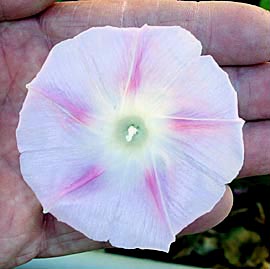
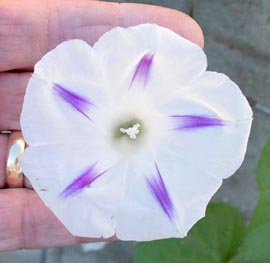
The
flowers are much blander in person than these photos show.
At five feet tall seven weeks after planting this is by far the fastest growing of this year's morning glories. It was also the first to flower, producing a washed out bloom just under 3-inches across. Based on the bland appearance of the flowers I'd doubt this is one I'd be interested in planting again. It does get credit for being by far the most prolific flower producer of the 2010 season. Viewed any further than 10 feet away, the flowers appear white. This might make them a good choice to mix in a few with a wall of Heavenly Blue or Bright Eyed Girl morning glories to provide some contrast.
At 12 weeks old the plant had topped 8 feet and had to be pruned back or it would have smothered the neighbor's roses.
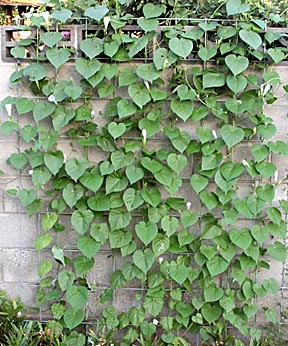
With medium dense foliage it makes an acceptable wall covering, though it's already showing signs of thinning near the bottom.
Cardinal Climber
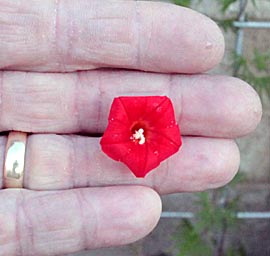
Cardinal Climber's flowers are so small that in spite of their brilliant color they are almost invisible. Although it's an excellent fast climber, the leaves of Cardinal Climber are so deeply cut...
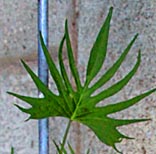
... that when viewed en-mass, it has the appearance of a horde of spiders swarming up the wall.
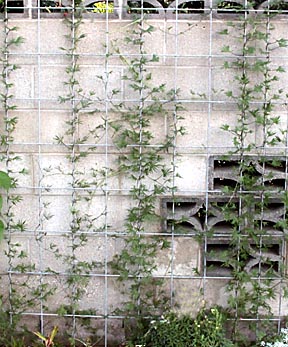
The plants and leaves are so open that even grown densely they make a poor wall covering. Although it's 12 weeks old and over 7 feet tall, the wall covering is almost as sparse as the number of flowers it's producing.
Blue Picotee
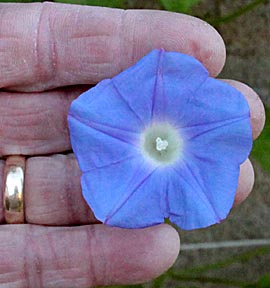
Blue Picotee is supposed to produce blue flowers rimmed with white. Mine looked like a miniature Heavenly Blue. It doesn't produce many flowers and most of those were hidden in the foliage.

The plant is an excellent climber and the second fastest grower this year.
Scarlet O'Hara
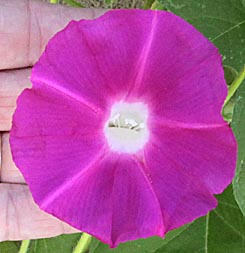
Although the flowers are attractive and 3-inches across, they took 16 weeks to appear and many were hidden under foliage.
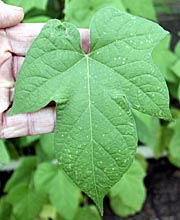
Different from the heart shaped leaves of most morning glories, those of Scarlet O'Hara are more lobed shaped. This creates an appearance suggestive of ivy. Although not obvious from this picture, Scarlet O'Hara leaves are a slightly lighter green than most morning glories. I'm not impressed with this variety's climbing ability. It's better than Mt. Fuji, but not by much. Expect to have to help many of the runners wrap around a trellis once a week.
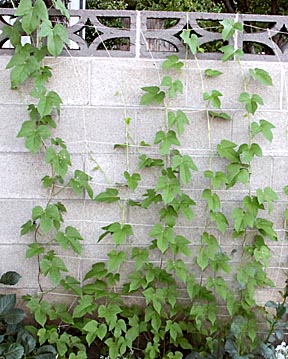
Twelve weeks after planting the vines are 6-feet tall.
Minibar Red
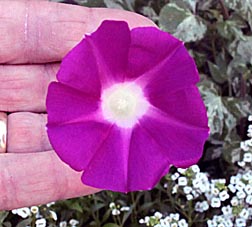
Minibar's magenta and white flowers are only 2.5 inches accross. Bright Eyed Girl's are larger and prettier on a much better plant.
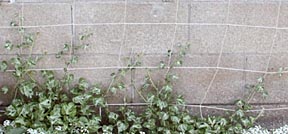
Although its leaves are attractively variegated, since it's grown just 18-inches in 12 weeks and a poor climber to boot, I have to rate this as an undesirable plant for covering walls.
Chocolate

While I acknowledge the achievement of developing a brown flower, I have to confess that although Chocolate Morning Glory's 4-inch flowers are large and refined, their color is so drab that I can't recommend this variety. The fact that it took 14 weeks for the first blossom to appear is also a point against this plant.
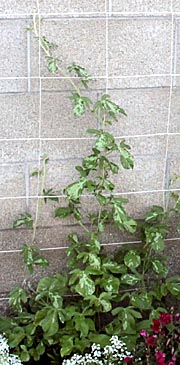
Fourteen weeks after planting, this variety's only 4-foot tall and is displaying variegated leaves. Such slow growth doesn't make it an effective wall cover.
Yellow
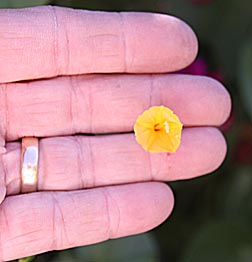
The flowers are so small that I can't be sure how long they took to bloom. I didn't spot them until 22 weeks after sowing seeds.

Three weeks of growth got this variety to 6-feet tall. It's a good climber but the plant is very spindly. Only one of the 10 seeds planted germinated. Neighboring morning glories quickly over grew it and by 12 weeks I'd assumed it had died. Then after 22 weeks I spotted tiny flowers that looked like a weed, but when traced back to their source turned out to be the long lost yellow morning glory vine. The small, uninteresting flowers and weak growth do not recommend this variety as a wall covering.
Sunrise Serenade
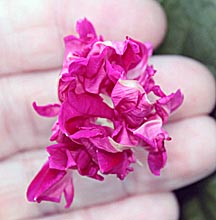
After waiting 15 weeks for the first Sunrise Serenade flower I was extremely disappointed that all I got was a tiny, 2-inch lump of shredded petals. This variety may have some novelty value but that's all, though I have to admit that by the end of the season the plant was well covered with blooms.
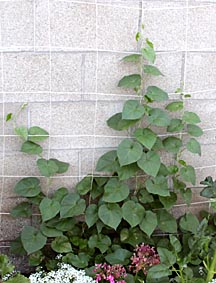
Twelve weeks after planting it's only 3-feet tall. At 15 weeks it was 6 feet tall. This is a slow grower in my high desert location.
Sunsmile
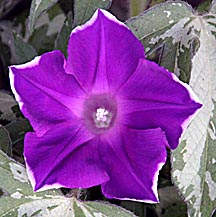
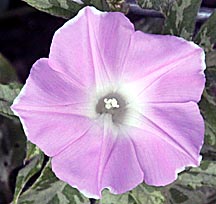
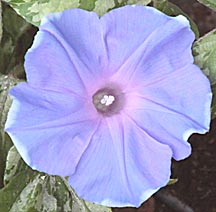
Sunsmile violet............................Sunsmile
pink..........................Sunsmile blue
It took 14 weeks for the first Sunsmile morning glory to bloom, and then all it produced was a 2-inch shriveled flower than died before it completely opened. Two better blooms appeared a week later, but they were again only 2 inches across.
Available in separate colors or red, pink, blue and violet, this variegated-leafed morning glory is a very slow grower that barely reached 9 inches tall after sixteen weeks of growth.
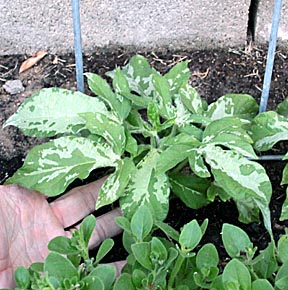
Since varieties on either side of this planting are already over six feet tall I'm confident that the slow growth is not the result of a soil deficiency. Since one of the criteria for a good morning glory is its ability to cover walls in a timely manner, Sunsmile is not going to be a front runner in the selection process. It might make an interesting ground cover, if it produced more flowers.
Candy Pink
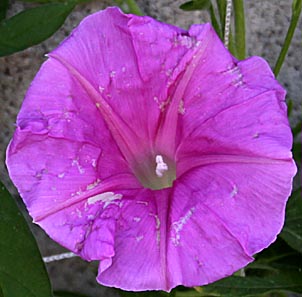
Large 4-inch flowers are an attractive pink but didn't appear until after 15 weeks. While many open crumpled as the above image shows, most are clean and well formed, like the following:
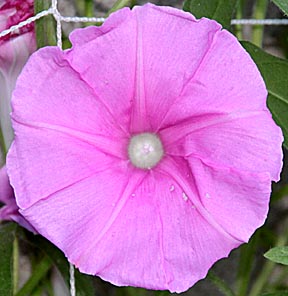
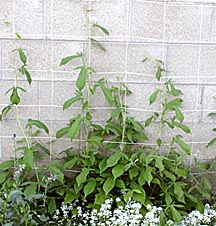
This is a short, bushy plant with deeply cut, lobed leaves. After 3 months it's only 3-feet tall. I found it to be a poor climber that required regular help. By 15 weeks it was just reaching 6 feet tall. However, by the end of the season it had covered a 6-foot wall and was putting on a glorious display of hundreds of flowers every morning. If you don't mind waiting for flowers, this variety puts on a great display.
Cameo Elegance

Late flowering with blooms barely 2 inches across, this is not one of my favorites.

A tiny plant with variegated leaves, it's less than two feet tall after three months. The plant shape is very bushy with many side sprouts. It looks a lot like variegated-leafed ivy, though not nearly as good a climber. To my eye, Cameo Elegance is identical in both plant and flower form and color to Minibar Red.
Flying Saucers
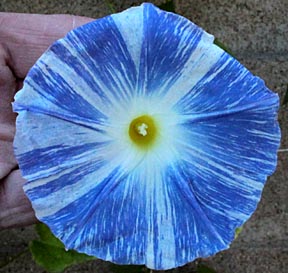
Well formed 3.5-inch flowers began blooming 12 weeks after planting. Attractive up close, the striped flowers fade to a bland gray-blue when viewed from more than 20 feet. As the plant matured it began producing perfectly formed trumpet shaped blossoms 4-inches across.
This fast grower hit 7 feet in three months. It's also an outstanding climber that seems to be more resistant to drooping from heat than other varieties. Like Blue Star, it doesn't produce a lot of side shoots so for dense cover it might be helpful to plant heavily or pinch early.
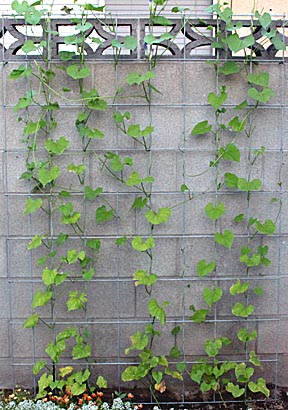
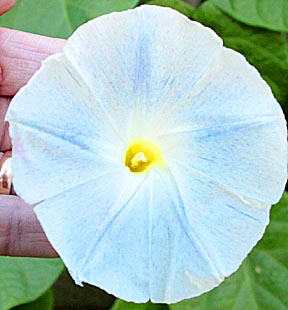
A month after the first flowers appeared, flower color began fading in new blooms. I assume this was in response to 100+ temperatures. Once temperatures dropped back into the low 90s bloom color improvred. In all honesty, the plants overlap so much that the faded blooms may have been from one rogue plant while the normal blooms from other plants.
After four months of growth, the bottom half of the plant is completely denuded of leaves making it unacceptable as a wall cover. The flowers have the tendency to open pointed upward and only form at the top of the plant so they are difficult to see. This is a variety I will not be planting again even though up close the flowers are beautiful. At 16 weeks the plant was effectively dead. Leaf yellowing and drop off suggest a soil borne virus was the problem. Since other morning glories growing next to these showed no signs of problems I'm assuming that Flying Saucers is more susceptible that most varieties.
Carnevale Di Venezia
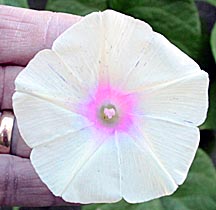
This variety produces small, 2.75-inch flowers with very subdued coloring.
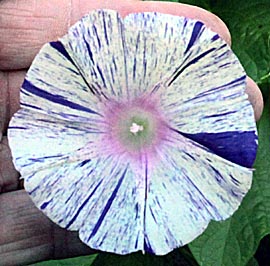
A few flowers exhibited blue stripes similar to Flying Saucers.
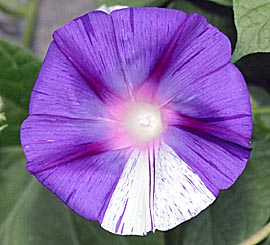
Other blossoms had large colored zones, in fact several where solid purple. While still others...
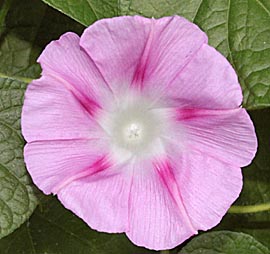
...were so differently colored that I suspect the seed packet had been contaminated with another variety. This was definetely the case with the Split Personality planting where one vine produced the dark purple flowers of Grandpa Ott.
Seven feet tall after twelve weeks I rate this as a good grower with excellent climbing habits.
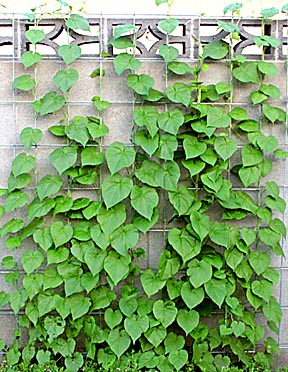
Its large, tropically lush leaves fill in nicely all the way to the bottom of the plant to create a dense wall covering. Unfortunately, it has produced very few flowers so it's not going to end up very high on the recommendations list.
Tie Dye Blue
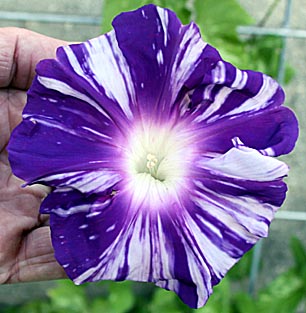
Although it's a slow grower, Tie Dye Blue produces large, beautifully striped 4-inch flowers. Unfortunately, the petals are thin, tear easily, many open crumpled and worst of all can open without the stripes that make them stand out, as the following image shows:
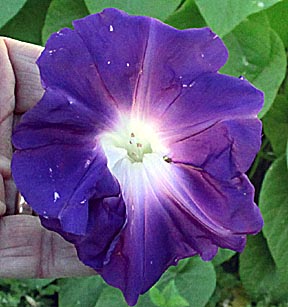
This bloom opened on the same plant, on the same day and from the same flower bunch as the first image. Two other blooms from this group had normal coloring, though they were smaller and badly crumpled.
Four of the plants were barely 1 foot tall after 12 weeks and the fifth was stretching to hit 3 feet.

At 14 weeks the tallest vine had just managed to hit six feet. The plants have attractively variegated foliage but are very open creating a poor wall cover. This may be a good one to skip because it grows so slowly. It took 14 weeks from planting to flower.
Some seeds must have gotten mixed up in the packet I purchased because one of the five vines produced purple flowers.
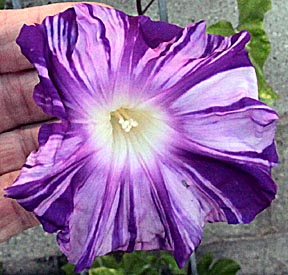
Some of its blooms were solid, as was the case with the blue vines. The following was a magnificent specimen measuring over four inches across:

By 16 weeks most of the vines had hit 6-feet. The plants produce almost no side runners so they look very sparse and don't cover the wall well. However, I'm happy to report that the flowers can last all day long even in 90+ temperatures. Many of the solid-colored flowers are huge and quite attractive.
Chocolate
Rose Silk

In spite of its name, Chocolate Rose Silk is identical to the Chocolate morning glory reviewed earlier except that its brown is slightly darker.
Another plant that may grow so slowly that even if it has beautiful flowers it may not be useful as a wall covering.
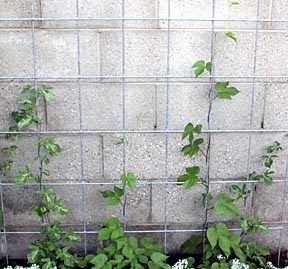
After 12 weeks of growth the plants vary from 2 to 4 feet tall. Some have variegated foliage while others are solid green. Since this is single variety I'm concerned that the seed pack had been contaminated with seeds from another morning glory.
Split Personality
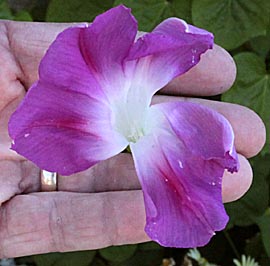
Split Personality produces hideously wrinkled and shredded looking blooms that are painful to look at. This is the best looking of the dozen blooms it's opened so far this year.
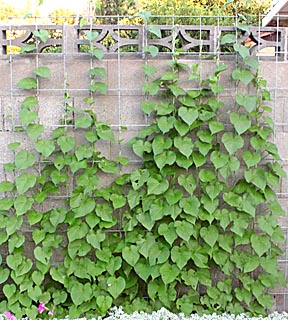
Six feet tall after 3 months, this plant has already proven itself an excellent climber that creates a dense covering.
One of the five vines produced solid flowers that were glorious.

If this is a true Split Personality variation, rather than from a different variety that accidentally found its way into my seed packet, then this is a type that could be a great hit if developed. (Note: the color difference is not as great in person as the pictures suggest.)
Akahibezaki Hinge
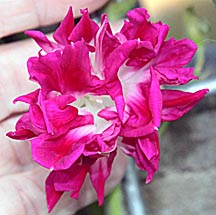
First appearing 15 weeks after planting, the small 2-inch diamter flowers look like a bundle of shredded petals and are almost identical to Sunrise Serenade.
Four feet tall after three months suggests this plant is a slow grower. It appreciates a little help getting started up a trellis but produces enough side shoots to fill in nicely.
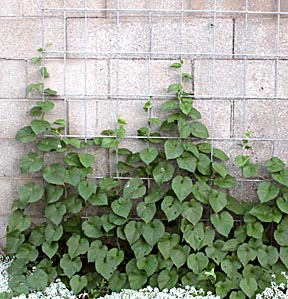
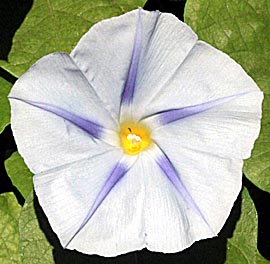
The 3.5-inch flowers are very attractive and almost identical to Blue Pastel Star. The plant flowered 8 weeks after planting seed.
After
a very late planting on June 21, this plant had very strong
germination and appears to be extremely vigorous.
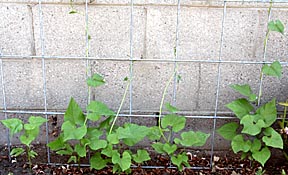
Three weeks after planting the tops of the two tallest plants hit 2 feet. Something tells me this is going to be a very fast grower. A month later they were topping the six foot tall wall against which they were growing. The leaves are lighter than most morning glories, providing a bright refreshing look. Both leave shape and color also suggest Milky Way is the same as Pastel Star.
Late in the season the leaves of both Milky Way and its look-alike Pastel Star had taken on an unhealthy yellow color that suggested a virus had infected them. None of the surrounding morning glories shouwed any sign of the problem. Also, these plants seemed to attract aphids while none of the other morning glories were bothered by them.
Pearly Gates
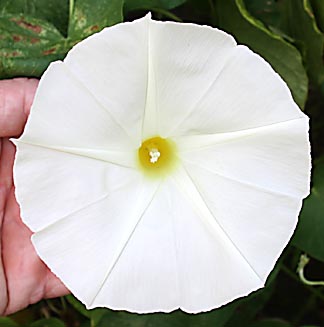
Pearly Gates boasts beautiful, huge flowers of the purest white with an attractive hint of yellow in the center. Planted in early Spring, this plant didn't start flowering until late September. The plants themselves were pale green, thin and slow growing. Although the flowers are great this is a variety I can't recommend.
End
Of Year Conclusion:
As of 17 September the 2010 morning glory season is officially over. There's still two months of flowering left before November's frosts kill the vines, but I don't expect any new developments between now and then. So far the clear winner is still "Bright Eyed Girl."
This completes this page. While there are a few more varieties available, none of them sound interesting enough to pursue. So, for next year I'll be focusing on growing Bright Eyed Girl (Crimson Rambler) and experimenting with ways to control its growth and create better flower displays.
2011 SEASON IS UNDERWAY!!!
On April 28 I planted 70 feet along an east-facing wall and 45-feet along a west facing wall solid with Crimson Rambler (Bright Eyed Girl) morning glories. The problem with doing so was that these are the same areas planted with morning glories last year. Those plants produced thousands of blooms which, when they matured, produced thousands of seed pods like the following:
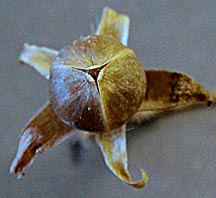
Shaken, the three sections of the 1/2-inch pod open, releasing up to six seeds. This means that the soil is contaminated with tens of thousands of morning glory seeds, most of which will germinate and be impossible to distinguish from the Crimson Rambler sprouts I want to keep. To avoid weeding out the desired plants with the unwanted ones, I scraped a 6-inch deep trench along the base of the trellises, placed my seeds in the bottom and covered them with two inches of potting soil. Scraping, instead of digging, insures that any weed seeds on the surface of the soil are pulled out of the area with the desired seeds. The trench also creates a nice watering trough for the seedlings. Now I know that any seeds germinating inside the trench are plants I want to keep and any outside it are weeds.
By June the vines covered the 6-foot trellises and the first flowers were blooming. I was disappointed to discover that fully 20-percent of the plants produced lighter pink flowers and another 5-percent were blues and purples. It would seem seed companies get a little careless when it comes to morning glory seeds.
The most important thing I've learned this season is that mass plantings of morning glories create vegetative monsters that endeavor of inundate anything they can reach. Unless you want your neighbor complaining about your vines strangling his or her favorite rose bush, I strongly recommend you prune or pull the vines away from the top of your trellis everyday. These devils grow so fast that left untended, in just a few days they can be completely out of control.
Until next time... good gardening!!!
Return to mainpage and view 100 other topics: everything from magnetic rocket engines and Knitting nancies to the strange world of lucid dreaming.